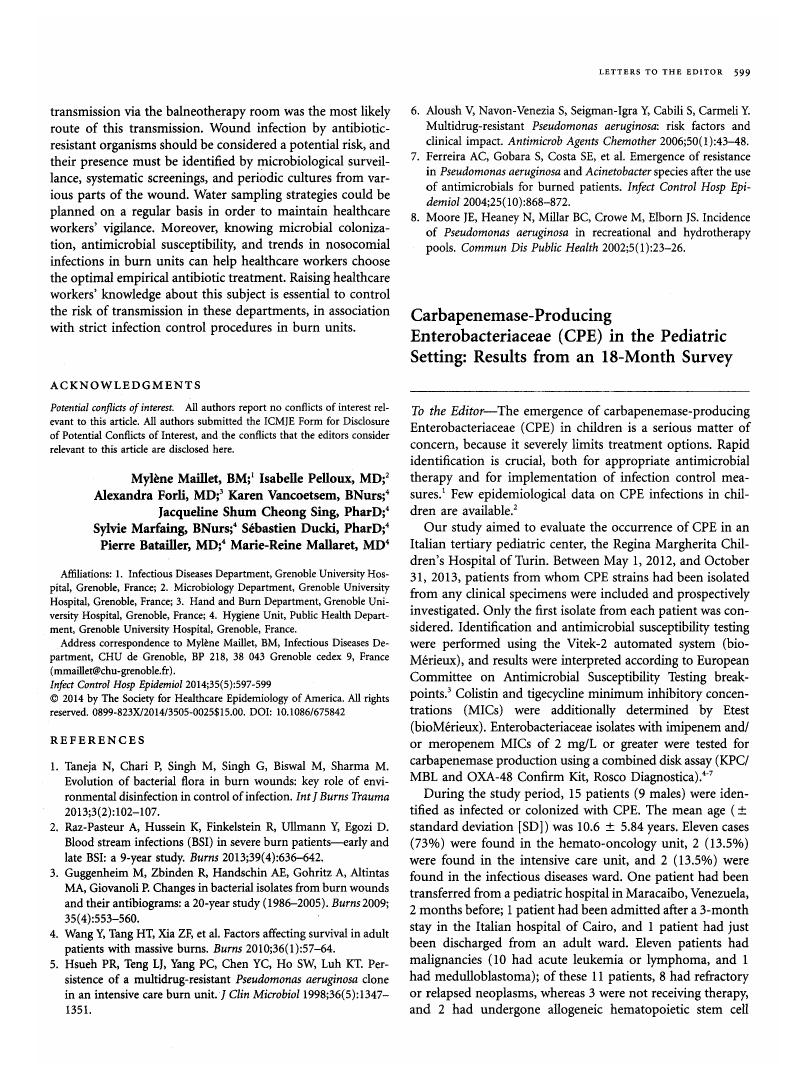Crossref Citations
This article has been cited by the following publications. This list is generated based on data provided by Crossref.
Chiotos, Kathleen
Han, Jennifer H.
and
Tamma, Pranita D.
2016.
Carbapenem-Resistant Enterobacteriaceae Infections in Children.
Current Infectious Disease Reports,
Vol. 18,
Issue. 1,
Caselli, Desiree
Cesaro, Simone
Fagioli, Franca
Carraro, Francesca
Ziino, Ottavio
Zanazzo, Giulio
Meazza, Cristina
Colombini, Antonella
and
Castagnola, Elio
2016.
Incidence of colonization and bloodstream infection with carbapenem-resistant Enterobacteriaceae in children receiving antineoplastic chemotherapy in Italy.
Infectious Diseases,
Vol. 48,
Issue. 2,
p.
152.
Chiotos, Kathleen
Tamma, Pranita D.
Flett, Kelly B.
Naumann, Matthew
Karandikar, Manjiree V.
Bilker, Warren B.
Zaoutis, Theoklis
and
Han, Jennifer H.
2017.
Multicenter Study of the Risk Factors for Colonization or Infection with Carbapenem-Resistant Enterobacteriaceae in Children.
Antimicrobial Agents and Chemotherapy,
Vol. 61,
Issue. 12,
Chiotos, Kathleen
Tamma, Pranita D
Flett, Kelly B
Karandikar, Manjiree V
Nemati, Koorosh
Bilker, Warren B
Zaoutis, Theoklis
and
Han, Jennifer H
2018.
Increased 30-Day Mortality Associated With Carbapenem-Resistant Enterobacteriaceae in Children.
Open Forum Infectious Diseases,
Vol. 5,
Issue. 10,
Castagnola, Elio
Tatarelli, Paola
Mesini, Alessio
Baldelli, Ivana
La Masa, Daniela
Biassoni, Roberto
and
Bandettini, Roberto
2019.
Epidemiology of carbapenemase-producing Enterobacteriaceae in a pediatric hospital in a country with high endemicity.
Journal of Infection and Public Health,
Vol. 12,
Issue. 2,
p.
270.
Aguilera-Alonso, David
Escosa-García, Luis
Saavedra-Lozano, Jesús
Cercenado, Emilia
and
Baquero-Artigao, Fernando
2020.
Carbapenem-Resistant Gram-Negative Bacterial Infections in Children.
Antimicrobial Agents and Chemotherapy,
Vol. 64,
Issue. 3,
Jia, Xiu-Qin
Pang, Feng
Xu, Juan-Juan
Xin, Ming
and
Zhang, Jian
2021.
Potential Effectiveness of Piperacillin/Tazobactam in Treating Pediatric Patients Infected with IMP-Type Carbapenemase-Producing Enterobacteriaceae.
Jundishapur Journal of Microbiology,
Vol. 13,
Issue. 12,
Liang, Yujian
Zhao, Chenfeng
Lu, Yuhang
Liao, Kang
Kong, Yannan
Hong, Mengzhi
Li, Liubing
and
Chen, Yili
2024.
Microbiological Characteristics, Risk Factors, and Short-Term Mortality of Carbapenem-Resistant Enterobacteriaceae Bloodstream Infections in Pediatric Patients in China: A 10-Year Longitudinal Study.
Infection and Drug Resistance,
Vol. Volume 17,
Issue. ,
p.
4815.
Micozzi, Alessandra
Luise, Cristina
Lisi, Chiara
Moleti, Luisa
Santilli, Stefania
and
Gentile, Giuseppe
2024.
Benefits and Safety of Empiric Antibiotic Treatment Active Against KPC-Producing Klebsiella pneumoniae for Febrile Neutropenic Episodes in Colonized Children with Acute Leukemia—An 8-Year Retrospective Observational Study.
Antibiotics,
Vol. 13,
Issue. 11,
p.
1017.



